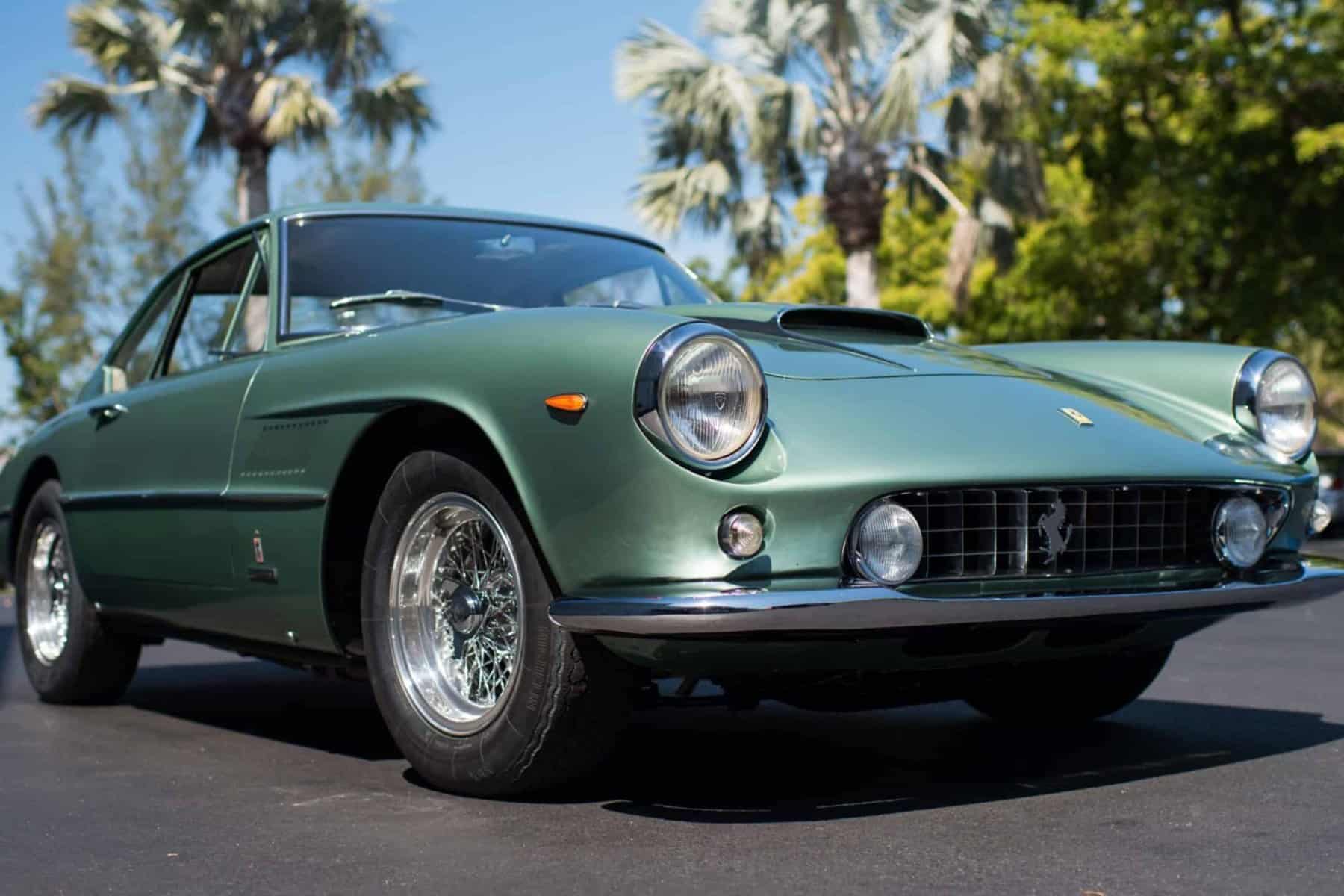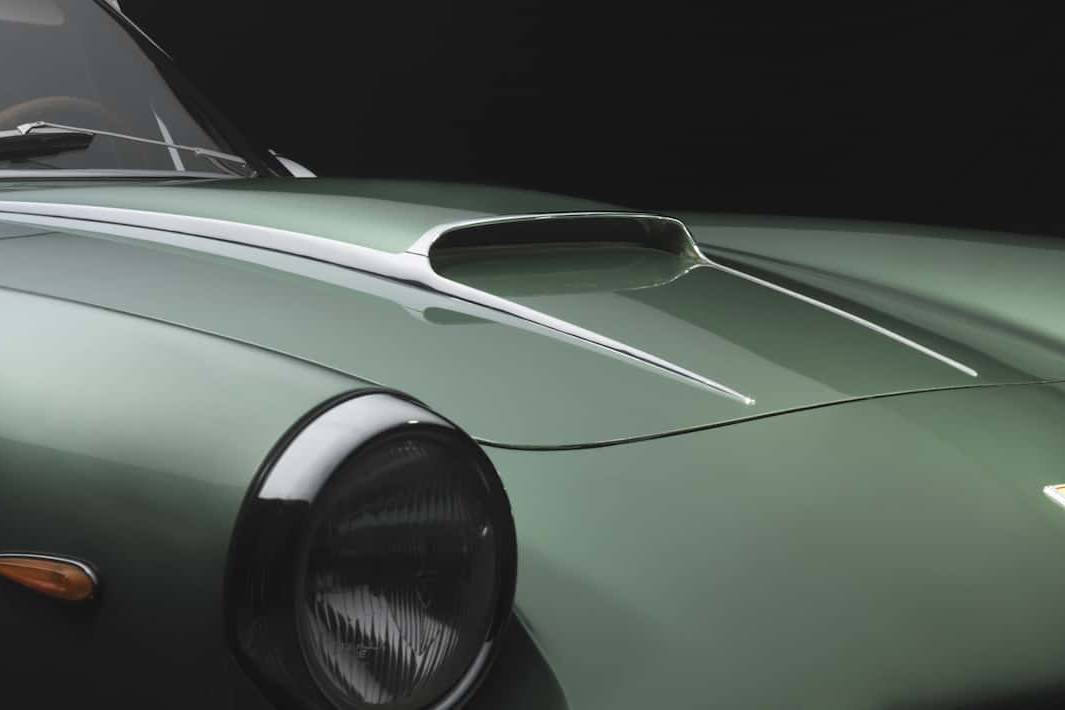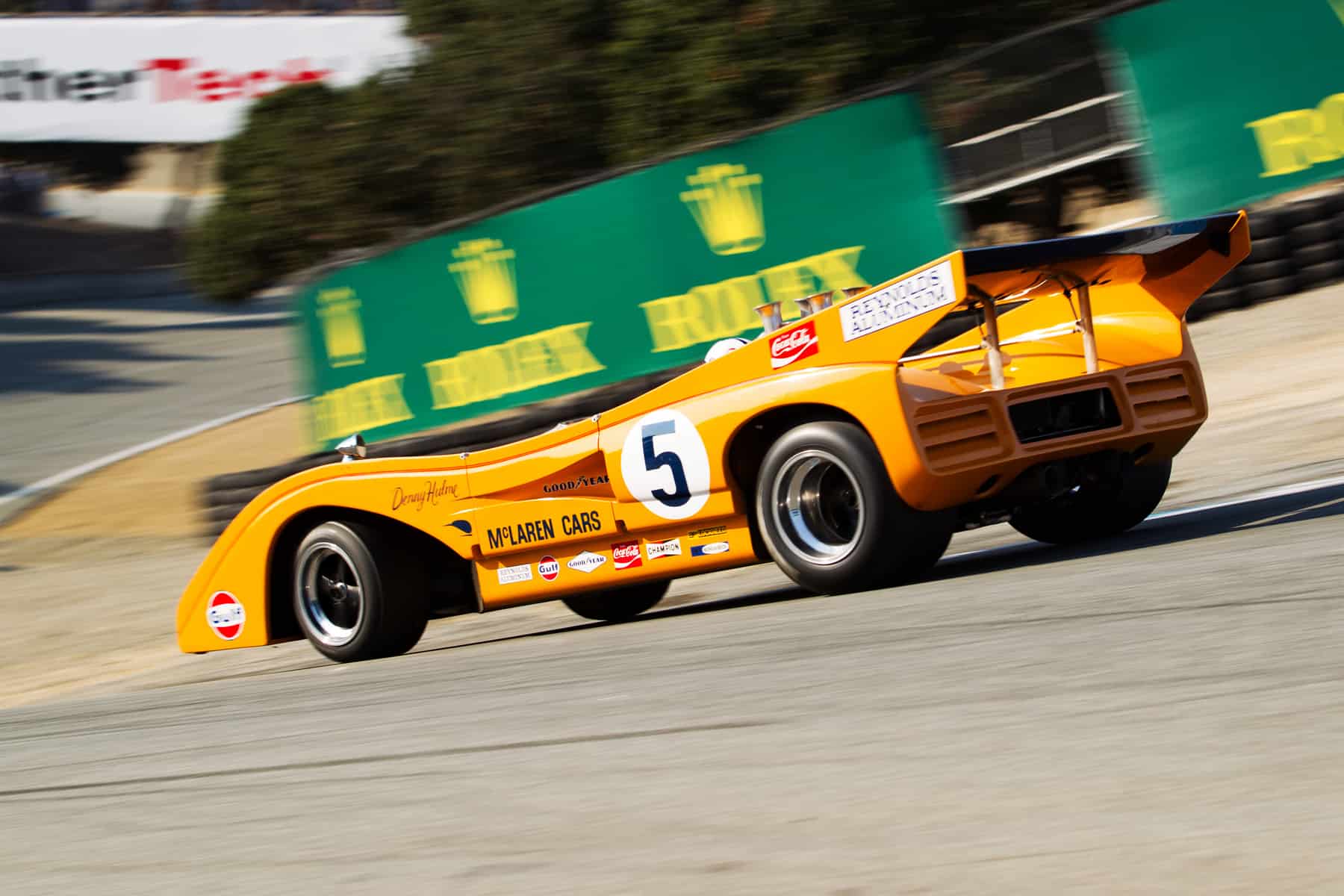
McLaren M8F
One of the wildest, most powerful machines motorsport has ever seen
BY: WOUTER MELISSEN
“It looks better to me than any other model McLaren or other brand of Can-Am car,” explains American historic racer Chris MacAllister, when asked why he bought a M8F. “Plus it was very successful, sounds awesome, and is a hoot to drive.”
The car in question is one of two M8Fs built by McLaren to compete in the 1971 Canadian-American Challenge Cup, otherwise known as the Can-Am series. Driven by New Zealand’s Denny Hulme and American, Peter Revson, the two cars were indeed very successful and ensured that McLaren dominated the series for a fifth consecutive season. The M8F’s “soundtrack” was provided by an absolutely massive, big-block Chevrolet V8 engine. MacAllister says, “When I would fire up the engine, all the dishes in the kitchen cupboards would rattle and my wife would come out and yell ‘Turn that thing off!’ Injected big-block Chevys have the best idle in the business!”
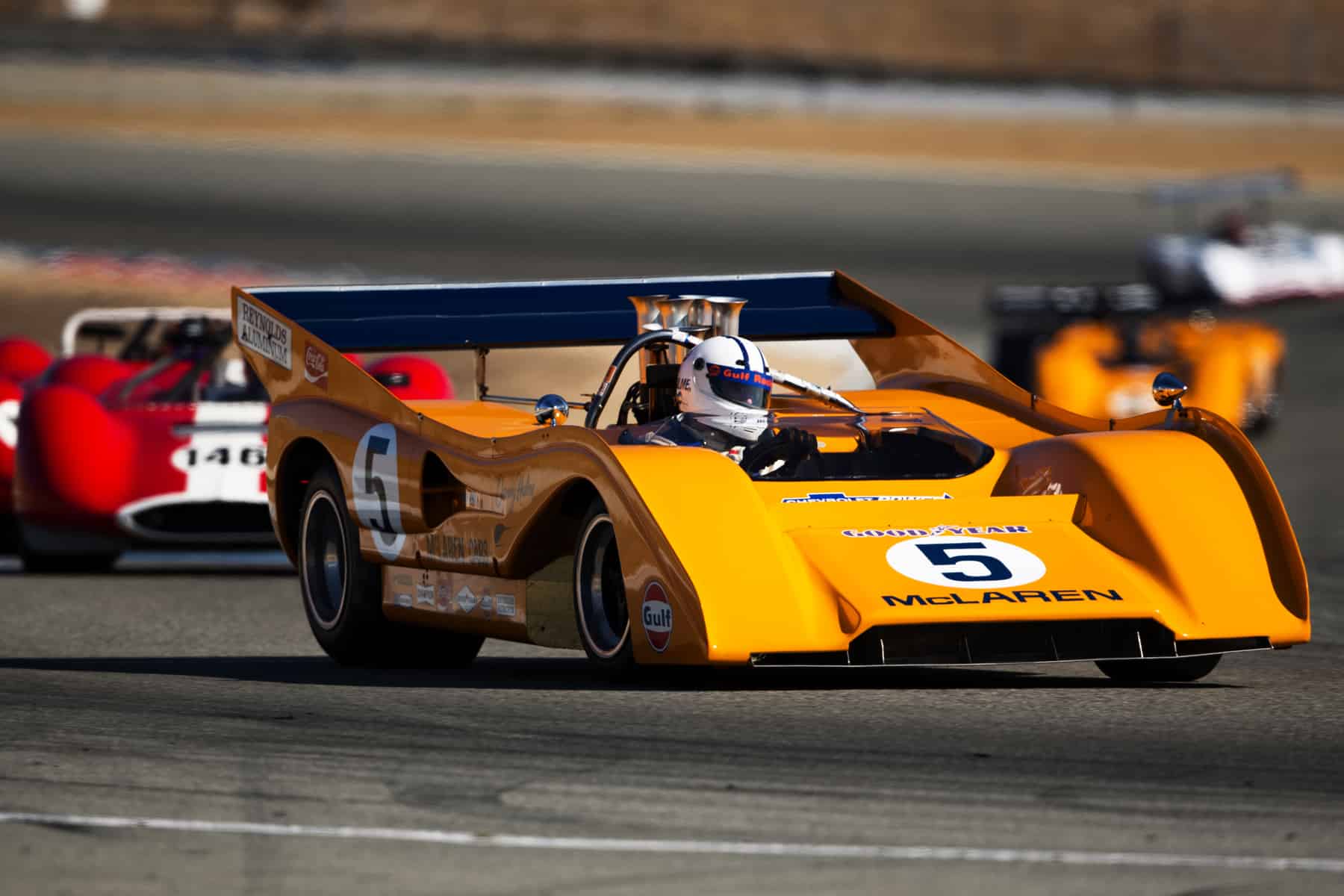
Run between 1966 and 1974, the original Can-Am series remains one of the absolute highlights of motorsport history. Lured by a sizeable prize provided by Johnson Wax and a rule book that really only stipulated that the cars should have two seats and enclosed wheels, it attracted entrants from both sides of the Atlantic. More importantly, the entrants were invited to build the wildest, most powerful machines the motorsport world had ever seen with no restrictions on engine size or aspiration. Can-Am’s heyday coincided with the arrival of down-force producing aerodynamics, so the mighty machines did not just go blisteringly fast in a straight line, they also cornered remarkably well. The liberal rulebook also inspired builders to produce unconventional and, eventually, highly influential machines.
By the time McLaren produced the M8F, the British team were Can-Am’s dominant force. Their dominance was such that at one point Can-Am was referred to as the Bruce-and-Denny Show, in reference to the team’s drivers, Bruce McLaren and Denny Hulme.

The best season for the Show was 1969 when McLarens won all 11 rounds of the Can-Am series. This was certainly not for a lack of competition, which included the likes of 1966 Can-Am winners Lola, Ferrari, Chaparral, and Shelby American, to name a few. With the Can-Am traditionally scheduled after the Formula 1 season, the series also attracted an all-star cast of drivers. The main competition for McLaren in 1971 came from Lola, who had managed to sign then two-time F1 World Champion Jackie Stewart to drive.
McLaren’s rivals exploited the lenient regulations to the fullest, fielding cars with one engine for each wheel, an ancillary snowmobile engine to create a vacuum underneath the car or wheels so small they looked to have come off a go-kart. The bright “Papaya” orange McLarens, by contrast, were very straightforward machines. The British team understood full well that the regulations allowed for very exotic solutions but they embraced reality – to win races, they needed a car that did not break down, was light and handled well. That recipe for success, first applied to the M8A introduced in 1968, continued all the way through to the M8F, as MacAllister can attest. “It is a very good handling car! It brakes, turns in, tracks and accelerates very well. You can throw it into a corner, make corrections at speed and it is not upset. You can push it very hard and it responds consistently and well.”
Originally designed by Gordon Cuppock and Jo Marquert, the 1968 Can-Am winning M8A was the first McLaren Can-Am racer to use Chevrolet’s big-block V8 engine. Not only did the all-alloy unit power the car, it also served as one-third of the chassis together with the Hewland gearbox. The drivetrain was bolted directly to the rear of the monocoque chassis. The chassis was built up around three steel bulkheads that were held together by sheets of aluminium to form a bathtub. The front suspension was bolted to the section between the first and second bulkheads while the driver and the massive 74 US Gallon fuel tanks were set between the second and third bulkheads. Using a semi-stressed engine and gearbox was not an entirely new idea but the M8A was the first top-level sports car to be built in such a way.
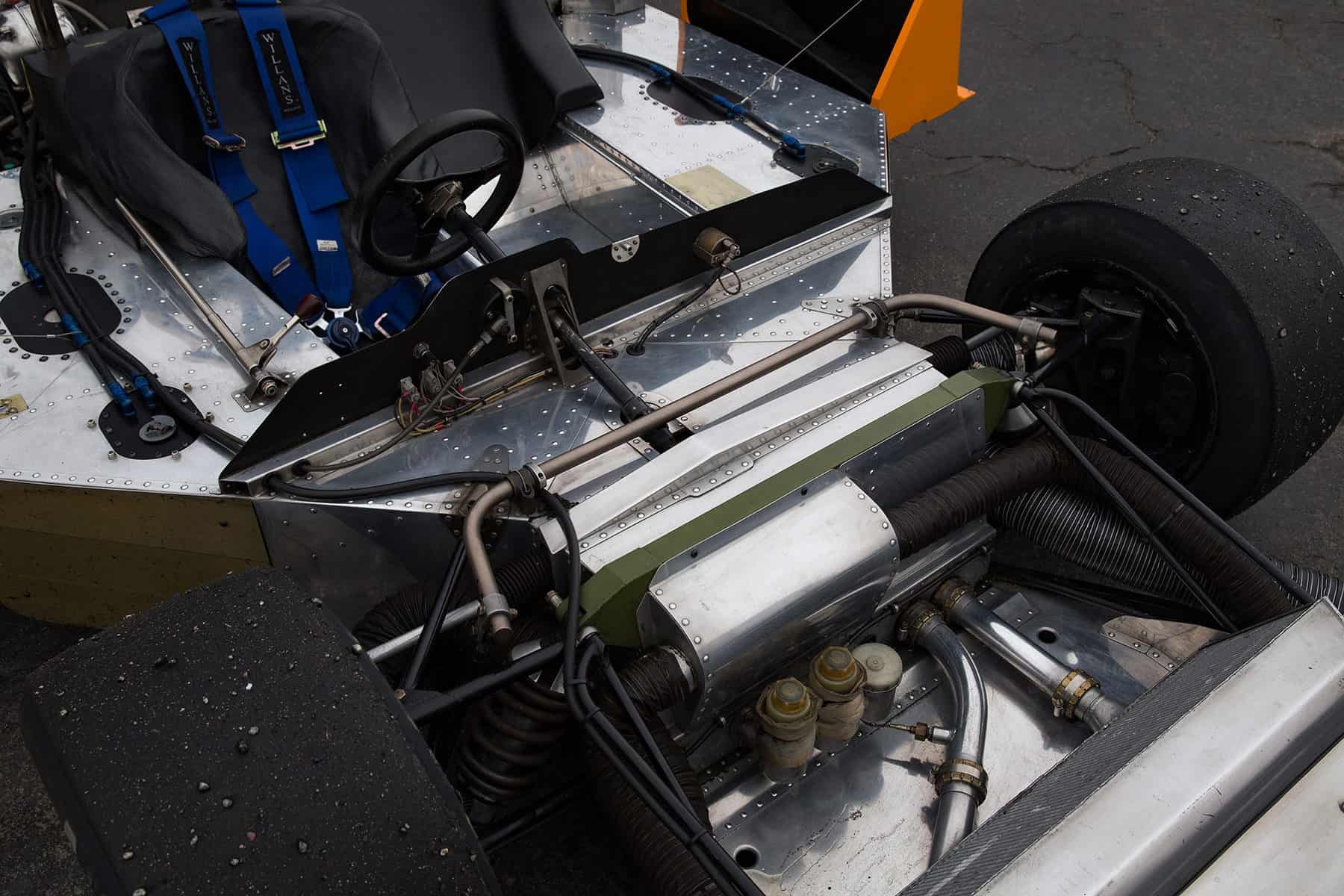
Above all, as there was no longer the need for a separate steel or aluminium frame to support the engine and rear suspension, the car was light.
Though it was based on Chevy’s all-aluminium big-block engine, the 427 cid V8 used was tuned specifically for McLaren at their North American facility by Gary Knutson. Fitted with Lucas fuel injection, it was quite modestly rated at 620 bhp, or 100 horses more than the cast-iron small block used in 1967, which was also a full 100 pounds heavier. To cope with the massive torque produced by the big-block engine, the five-speed Hewland gearbox was replaced by a sturdier and also lighter four-speed unit. Over the years, the big-block engine was further developed – that is, enlarged – and by 1971 a “sleeveless” 510 cid version, rated at well over 700 bhp, was used. In the sleeveless engine no cylinder liners were fitted, which allowed for even larger pistons to be used.
A thing of beauty to behold, the big-block V8 featured staggered intake trumpets that created a much smoother power delivery than conventional intake trumpets. The engine currently fitted in MacAllister’s M8F is a sleeveless V8 built by Keith Black. Displacing 509 cid, it produces 830 bhp at 6,600 rpm and a tarmac-shredding 760 pounds per foot of torque. MacAllister says, “The threat of wheel spin is something to watch for. Thankfully, the car is equipped with a throttle linkage with very long travel which helps in modulating the power.”
In addition the engine, the M8 chassis also gradually grew in size but what really sets the four distinct versions (M8A, M8B, M8D and M8F) apart is the bodywork. The evolution perfectly illustrates the rapid development of the understanding of aerodynamics during the era. While, the M8A started life with a big lip on the edge of the rear bodywork, the M8B featured a full size wing that was mounted directly on the rear suspension. This proved as dangerous as it was effective as the constant movement of the suspension caused catastrophic wing failures. With this solution banned ahead of the 1970 season, McLaren settled on a full width rear wing that was mounted between two fins on the rear bodywork with the M8D. This design was further refined for the M8F, which was wider and longer than the model it replaced. The fins now ran from the tip of the nose all the way to the tail to channel as much air as possible to the rear wing. The progress made in four years was staggering; despite being 100 pounds heavier than the M8A, the M8F was about six seconds per lap faster around Riverside.

Nevertheless, at the opening round of the 1971 season, McLaren drivers Hulme and Revson had far from smooth sailing as Jackie Stewart managed to qualify his equally new Lola T260 on the pole. But within five laps, it was business as usual and Hulme and Revson scored a one-two debut victory at Mosport with the M8Fs. Stewart upset the order two weeks later at St Jovite, this time by beating the two McLarens in a straight fight. The Scot would win once more that year, when both M8Fs failed, but every other race in the series was won by either Revson or Hulme. With five wins to Hulme’s three, Revson was crowned the 1971 champion.
This would be the final year of McLaren dominance, as Porsche stepped up their efforts in 1972 with the turbocharged 917s. The hot-rodded V8s simply proved no match, at least on power, for the sophisticated German engines that produced as much as 1,200 bhp on full boost. McLaren’s all-new M20 did prove more reliable and Hulme managed to score three wins in 1972. F1 ace François Cevert also scored a win with one of the ex-works M8Fs. Realizing there was no viable route back to success, McLaren left Can-Am at the end of the 1972 season.
Both M8Fs used by McLaren during the 1971 season have survived and are in caring hands. The ex-Revson car is on permanent display in the Louwman Museum, in The Hague, the Netherlands. Hulme’s M8F chassis 1 has formed part of MacAllister’s formidable stable for the better part of two decades now. Fully aware and in awe of the car’s history, he races the big McLaren in matching attire. “I try to display and use all my cars in the manner in which they were used in period. Livery, physical configuration, engine, driver’s suit, helmet, everything as close to the way it was done back in the day as I can make it.”

Although he is very successful behind the wheel of the M8F, MacAllister is also a stickler for originality. “To me, using and displaying old cars the way they were made is more important than modifying them to be more competitive. I’d rather be true to the car than make it faster by updating it. I think some fellow competitors and fans appreciate originality more than competitiveness.”
The thought of racing a 830 bhp, 1,520-pound car would scare most people, but not MacAllister. “I have a healthy respect for it and have spun it a few times. The car is very physical to drive. The G-forces are higher than any other car I’ve driven. The steering is really heavy. The gear change is quite heavy and slow. The cockpit is remarkably small for such a big car so the driver is packed in his seat like a sardine.”
He concludes exactly where one might expect: “It is a really fun car to drive!”



